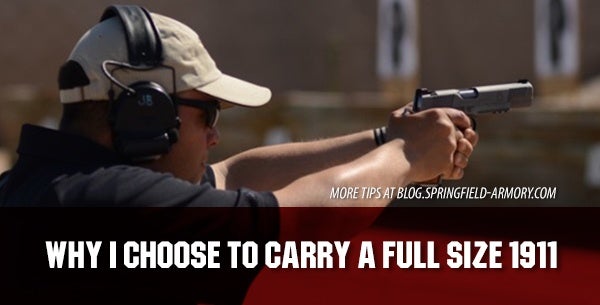Sponsored Post: Why I Choose To Carry A Full Size 1911
AllOutdoor Staff 06.09.15
 Sponsored Post: Why I Choose To Carry A Full Size 1911" title="Sponsored Post: Why I Choose To Carry A Full Size 1911" width="600" height="305" style="max-width: 1200px;">
Sponsored Post: Why I Choose To Carry A Full Size 1911" title="Sponsored Post: Why I Choose To Carry A Full Size 1911" width="600" height="305" style="max-width: 1200px;">**This article is sponsored by Springfield Armory and originally posted on their blog.**
There are plenty factors that play into the decision of what pistol to use as an everyday carry gun.
After carrying a pistol in one form or another for the last 17+ years, one thing I can conclude is that a full-size 1911 is one of the easiest pistols to carry in a concealed format… at least for me.
With all the various options, formats, and configurations available, people still ask me why I continue to choose a full-sized 1911 over other popular sizes.
For me, it’s a pretty easy answer that can be broken down into three basic parts: carryability, reliability and shootability.
CARRYABILITY OF A FULL SIZE 1911
While some might consider a full size 1911 to be large and heavy, there are two significant advantages to carrying one; it’s flat and balanced.
The “flat” part is easy to figure out. The 1911 has always had exceptional ergonomics due to the location of the controls and its single stack configuration.
It’s thin, flat profile helps make the gun disappear under most garments, which for us in Arizona is often a light t-shirt.
When carried in a proper holster mounted on a quality belt, the entire package is remarkably well balanced with the loaded magazine being offset by the length and weight of the steel slide and frame.
My preference is carrying in an inside the waistband holster because the flat profile of the gun/holster against your body further enhances this balance, making the gun all-day comfortable.
RELIABILITY OF A FULL SIZE 1911
Size plays a huge role in the overall reliability of any gun.
A full-size 1911 has a cycle length that produces a generous amount of slide travel (stroke) resulting in a longer dwell time when compared to 1911s with shorter slides.
Shortening the cycle length of a 1911 directly affects how much time the gun has to eject the spent casing as well as the amount of time the magazine has to feed the next round to the top of the feed-lips.
This may be one of the reasons some shorter 1911s have not worked as well (or at all) in the past. The slides were simply outrunning the rest of the gun.
A pistol with a shorter cycle length will typically be less forgiving of faulty, fatigued, worn out magazines or magazine springs.
That’s not to say they can’t work, but over a long period of time, a full-size 1911 will typically be more forgiving and reliable.
SHOOTABILITY OF A FULL SIZE 1911
The size and weight of the full-size 1911 results in largely unparalleled handling characteristics.
The long, slow recoil impulse of the .45ACP round combined with the slide weight and full-length grip frame helps the gun remain flat during recoil to allow for a true full-firing grip on the pistol.
This full-length grip not only makes the pistol easier to handle but also helps to eliminate the potential pinching of your fingers during a magazine exchange or reload–something that lots of shooters experience with pistols that have a shorter grip frame.
The slide on a full-size 1911 allows for a generous sight radius and does not require a special configuration for the recoil spring/recoil assembly.
When you combine the full weight and grip length of the steel frame with the slide travel of a full-size 1911, the resulting product is best summed up by what a wise man once said:
“It’s a big gun when you carry it and it’s a big gun when you pull it out to shoot.”